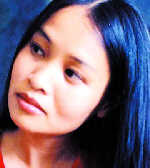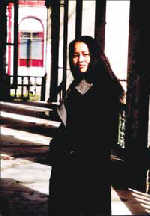 As Duomi grows up, however, she learns to consider intimacy with other women as abnormal and comes to identify her childhood same-sex play as shameful. Even though Lin does not explicitly criticize homophobia as a social construct, her depiction of a protagonist who constrains her own spontaneous polymorphous desires because of society's prejudices against homosexuals sets the stage for future critiques of lesbian self-denial.
As Duomi grows up, however, she learns to consider intimacy with other women as abnormal and comes to identify her childhood same-sex play as shameful. Even though Lin does not explicitly criticize homophobia as a social construct, her depiction of a protagonist who constrains her own spontaneous polymorphous desires because of society's prejudices against homosexuals sets the stage for future critiques of lesbian self-denial.
At one level of meaning, this novel subverts male-dominated society. However, male critics really welcomed the work, and enthusiastically praised it.
 Lin's Reflections
Lin's Reflections
Lin tends to construct her works as a reflection of her world. Narcissism can be easily sensed in her words. It's a self-appreciation that eliminates a male perspective.
The Seat on the Verandahshows Lin's views in this regard. The story is "about strangers in a local place, their revolution, the friendship between a mistress and her maiden, a mysterious verandah, the scent of tea and lavender, all of which hide in a red mansion almost invisible in fog and flurry." It weakens the male characters and focuses on the story of Zhu Liang and Qi Ye.
The story begins with a picture of Zhu Liang, though, it's hard to find a plot or story in the novel, or a man depicted. All that can be deduced is the virtual happenings between the two women. They consider each other as a person with secret connections.
In the story, by appreciating the beauty of a woman in another woman's eyes, Lin excludes the impacts of man, and reveals the real beauty a woman exudes.
Some critics think that, within her soul, Lin is a poet. She is not an expert in writing intriguing stories or logic. The highlights of her novels are always those patches of narration featuring female beauty.
 Excerpt
Excerpt
 I once saw a photograph of Zhu Liang in her youth. She had posed sitting. The sharp contrasts in the black-and-white picture gave the image a strong three-dimensional effect. The woman in the picture was wearing a full-length cheongsam slit to the thigh, a style popular in Shanghai in the 1940s. Her body was supple and curvaceous, and her face radiated beauty. This beautiful glow, like an eternal aura, enveloped Zhu Liang throughout her youth. Her gaze in this photograph fixed itself on me across half a century.
I once saw a photograph of Zhu Liang in her youth. She had posed sitting. The sharp contrasts in the black-and-white picture gave the image a strong three-dimensional effect. The woman in the picture was wearing a full-length cheongsam slit to the thigh, a style popular in Shanghai in the 1940s. Her body was supple and curvaceous, and her face radiated beauty. This beautiful glow, like an eternal aura, enveloped Zhu Liang throughout her youth. Her gaze in this photograph fixed itself on me across half a century.
The two-inch-by-two-inch photograph was set in an elephant-bone frame of a clean and simple design. The new frame set off the old yellow photograph. This frame did not belong to her, its owner said. Her voice was filled with deep nostalgia, like that of a doddering man remembering an undying love from his youth so beautiful and tragic he has never been able to forget it.
